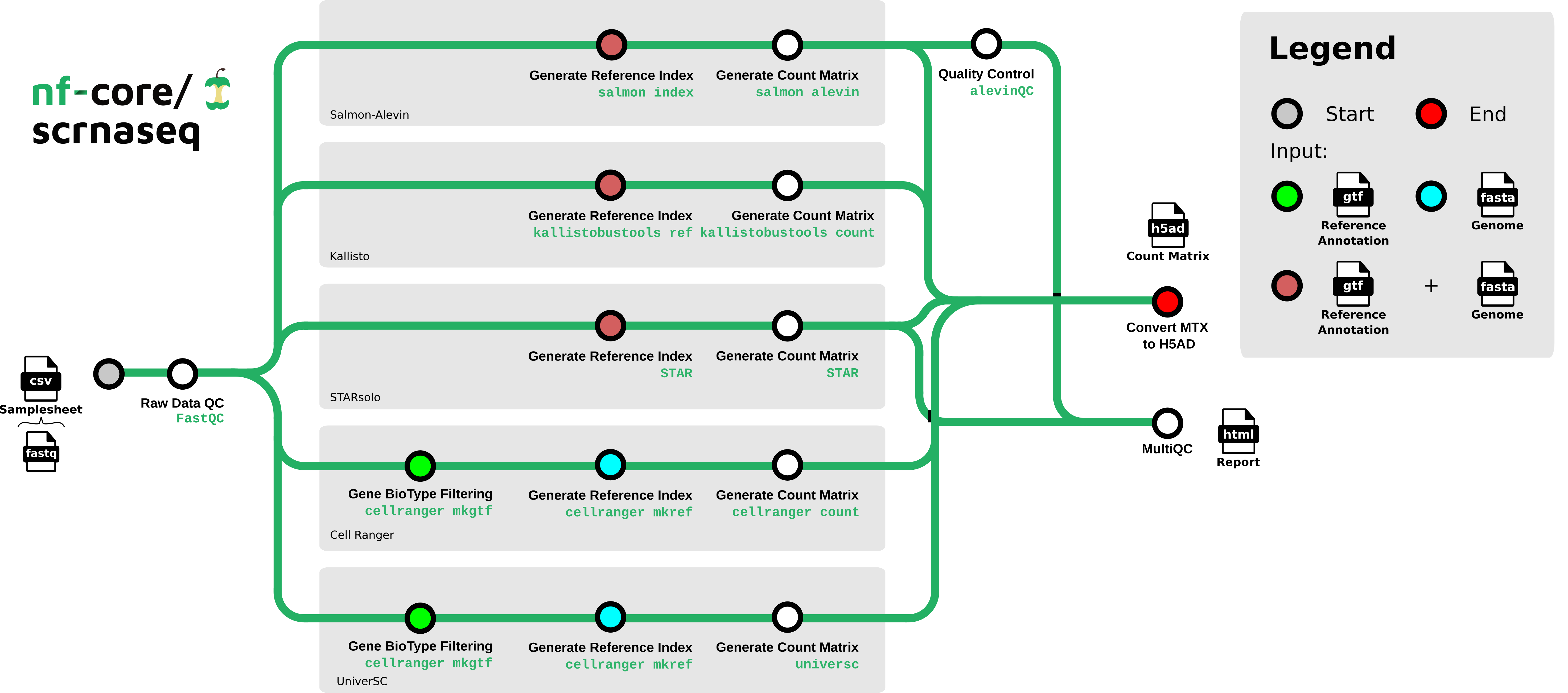nf-core/scrnaseq
Single-cell RNA-Seq pipeline for barcode-based protocols such as 10x, DropSeq or SmartSeq, offering a variety of aligners and empty-droplet detection
2.2.0). The latest
stable release is
4.1.0
.
Introduction
nf-core/scrnaseq is a bioinformatics best-practice analysis pipeline for processing 10x Genomics single-cell RNA-seq data.
The pipeline is built using Nextflow, a workflow tool to run tasks across multiple compute infrastructures in a very portable manner. It uses Docker/Singularity containers making installation trivial and results highly reproducible. The Nextflow DSL2 implementation of this pipeline uses one container per process which makes it much easier to maintain and update software dependencies. Where possible, these processes have been submitted to and installed from nf-core/modules in order to make them available to all nf-core pipelines, and to everyone within the Nextflow community!
On release, automated continuous integration tests run the pipeline on a full-sized dataset on the AWS cloud infrastructure. This ensures that the pipeline runs on AWS, has sensible resource allocation defaults set to run on real-world datasets, and permits the persistent storage of results to benchmark between pipeline releases and other analysis sources. The results obtained from the full-sized test can be viewed on the nf-core website.
This is a community effort in building a pipeline capable to support:
- Alevin-Fry + AlevinQC
- STARSolo
- Kallisto + BUStools
- Cellranger
- UniverSC
Documentation
The nf-core/scrnaseq pipeline comes with documentation about the pipeline usage, parameters and output.

Quick Start
-
Install
Nextflow(>=22.10.1) -
Install any of
Docker,Singularity(you can follow this tutorial),Podman,ShifterorCharliecloudfor full pipeline reproducibility (you can useCondaboth to install Nextflow itself and also to manage software within pipelines. Please only use it within pipelines as a last resort; see docs). -
Download the pipeline and test it on a minimal dataset with a single command:
nextflow run nf-core/scrnaseq -profile test,YOURPROFILE --outdir <OUTDIR>Note that some form of configuration will be needed so that Nextflow knows how to fetch the required software. This is usually done in the form of a config profile (
YOURPROFILEin the example command above). You can chain multiple config profiles in a comma-separated string.- The pipeline comes with config profiles called
docker,singularity,podman,shifter,charliecloudandcondawhich instruct the pipeline to use the named tool for software management. For example,-profile test,docker. - Please check nf-core/configs to see if a custom config file to run nf-core pipelines already exists for your Institute. If so, you can simply use
-profile <institute>in your command. This will enable eitherdockerorsingularityand set the appropriate execution settings for your local compute environment. - If you are using
singularity, please use thenf-core downloadcommand to download images first, before running the pipeline. Setting theNXF_SINGULARITY_CACHEDIRorsingularity.cacheDirNextflow options enables you to store and re-use the images from a central location for future pipeline runs. - If you are using
conda, it is highly recommended to use theNXF_CONDA_CACHEDIRorconda.cacheDirsettings to store the environments in a central location for future pipeline runs.
- The pipeline comes with config profiles called
-
Start running your own analysis!
nextflow run nf-core/scrnaseq --input samplesheet.csv --outdir <OUTDIR> --genome_fasta GRCm38.p6.genome.chr19.fa --gtf gencode.vM19.annotation.chr19.gtf --protocol 10XV2 --aligner <alevin/kallisto/star/cellranger/universc> -profile <docker/singularity/podman/shifter/charliecloud/conda/institute>
Decision Tree for users
The nf-core/scrnaseq pipeline features several paths to analyze your single cell data. Future additions will also be done soon, e.g. the addition of multi-ome analysis types. To aid users in analyzing their data, we have added a decision tree to help people decide on what type of analysis they want to run and how to choose appropriate parameters for that.
Loading graph
Options for the respective alignment method can be found here to choose between methods.
Credits
nf-core/scrnaseq was originally written by Bailey PJ, Botvinnik O, Marques de Almeida F, Gabernet G, Peltzer A, Sturm G.
We thank the following people for their extensive assistance in the development of this pipeline:
- @heylf
- @KevinMenden
- @FloWuenne
- @rob-p
Contributions and Support
If you would like to contribute to this pipeline, please see the contributing guidelines.
For further information or help, don’t hesitate to get in touch on the Slack #scrnaseq channel (you can join with this invite).
Citations
If you use nf-core/scrnaseq for your analysis, please cite it using the following doi: 10.5281/zenodo.3568187
The basic benchmarks that were used as motivation for incorporating the three available modular workflows can be found in this publication.
We offer all three paths for the processing of scRNAseq data so it remains up to the user to decide which pipeline workflow is chosen for a particular analysis question.
An extensive list of references for the tools used by the pipeline can be found in the CITATIONS.md file.